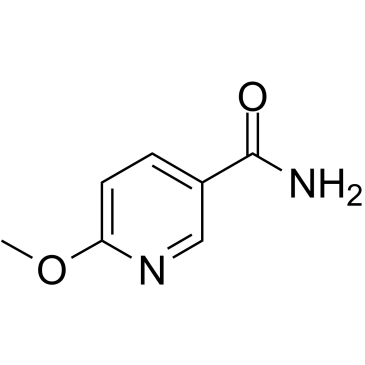| Cas No.: | 7150-23-4 |
| Chemical Name: | 6-Methoxynicotinamide |
| Synonyms: | JBSNF000088;6-Methoxynicotinamide |
| SMILES: | COc1ccc(cn1)C(=O)N |
| Formula: | C7H8N2O2 |
| M.Wt: | 152.153 |
| Purity: | >98% |
| Sotrage: | 2 years -20°C Powder, 2 weeks4°C in DMSO,6 months-80°C in DMSO |
| Description: | JBSNF-000088 (6-Methoxynicotinamide), a analog of nicotinamide (NA), is a potent Nicotinamide N-methyltransferase (NNMT) inhibitor with IC50s of 1.8 µM, 2.8 µM, and 5.0 µM for human NNMT, monkey NNMT and mouse NNMT, respectively. JBSNF-000088 inhibits NNMT activity, reduces MNA levels and drives insulin sensitization, glucose modulation and body weight reduction in animal models of metabolic disease[1]. |
| Target: | IC50: 1.8 µM (human NNMT), 2.8 µM (monkey NNMT) and 5.0 µM (mouse NNMT)[1] |
| In Vivo: | JBSNF-000088 (6-Methoxynicotinamide) (50 mg/kg; oral route of administration for four weeks) shows statistically significant reduction in body weight (%) and leads to a statistically significant reduction in fed blood glucose on day 21[1]. JBSNF-000088 (50 mg/kg; oral gavage administration; twice daily for four weeks) leads to a statistically significant improvement in oral glucose tolerance on day 28 with glucose tolerance being normalized[1]. JBSNF-000088 (1 mg/kg; intravenous administration; for 4 hours) results in low plasma clearance of 21 mL/min▪kg and the volume of distribution at steady state of 0.7 L/kg, a very short plasma half-life of 0.5 hours upon intravenous administration[1]. JBSNF-000088 (10 mg/kg; oral gavage; for 4 hours) results in a Cmax of 3568 ng/mL with a Tmax value of 0.5 hours, indicating rapid absorption in the intestine, and half-life of 0.4 hours by oral gavage. The oral bioavailability is found to be approximately 40%[1]. Animal Model: Mice with high fat diet (HFD)-induced obesity[1] Dosage: 50 mg/kg Administration: Oral route of administration for four weeks; oral gavage administration and twice daily for four weeks Result: Showed statistically significant reduction in body weight (%) and led to a statistically significant reduction in fed blood glucose on day 21 by oral route of administration. Led to a statistically significant improvement in oral glucose tolerance on day 28 with glucose tolerance being normalized by oral gavage administration. Animal Model: C57BL/6 mice[1] Dosage: 1 mg/kg (Intravenous administration);10 mg/kg (oral gavage)(Pharmacokinetic Study) Administration: Intravenous administration and oral gavage; for 4 hours Result: Resulted in low plasma clearance of 21 mL/min▪kg and the volume of distribution at steady state of 0.7 L/kg, a very short plasma half-life of 0.5 h upon intravenous administration. Resulted in a Cmax of 3568 ng/mL with a Tmax value of 0.5 hours, indicating rapid absorption in the intestine, and half-life of 0.4 hours by oral gavage. |
| In Vitro: | JBSNF-000088 (6-Methoxynicotinamide) has IC50 values are 1.6 and 6.3 µM for U2OS or differentiated 3T3L1 cells[1]. |
| References: | [1]. Kannt A, et al. A small molecule inhibitor of Nicotinamide N-methyltransferase for the treatment of metabolic disorders. Sci Rep. 2018 Feb 26;8(1):3660. |

 To enhance service speed and avoid tariff delays, we've opened a US warehouse. All US orders ship directly from our US facility.
To enhance service speed and avoid tariff delays, we've opened a US warehouse. All US orders ship directly from our US facility.




















